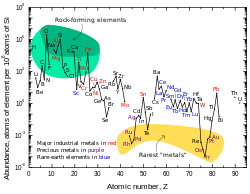Abundance of chemical elements
| Z | Element | Mass fraction (ppm) |
|---|---|---|
| 1 | Hydrogen | {{{1}}} 739,000
|
| 2 | Helium | {{{1}}} 240,000
|
| 8 | Oxygen | {{{1}}} 10,400
|
| 6 | Carbon | {{{1}}} 4,600
|
| 10 | Neon | {{{1}}} 1,340
|
| 26 | Iron | {{{1}}} 1,090
|
| 7 | Nitrogen | {{{1}}} 960
|
| 14 | Silicon | {{{1}}} 650
|
| 12 | Magnesium | {{{1}}} 580
|
| 16 | Sulfur | {{{1}}} 440
|
| Total | {{{1}}} 999,060
|
The elements are only a small part of the content of the Universe. By "elements" is meant ordinary (baryonic) matter made of protons, neutrons, and electrons.
Observations suggest that only 4.6% of the universe's energy makes up the visible (baryonic) matter of the universe. That includes the energy (E = mc2 ⇔ m = E / c2) in stars, planets, and living beings.
The rest is thought to be made up of dark energy (68%) and dark matter (27%).[2] These are forms of matter and energy are believed to exist on the basis of scientific theory and inductive reasoning. They are based on observations, but they have not been directly observed. Their nature is not well understood.
Most standard (baryonic) matter is found in intergalactic gas, stars, and interstellar clouds, in the form of atoms or ions (plasma). Degenerate forms are found in extreme settings, such as the high densities inside white dwarfs and neutron stars.
The inner planets of the Solar System are unusual because they have a high amount of heavier elements. These heavier elements were formed in earlier supernovae.[3][4]
Abundance Of Chemical Elements Media
Abundance (atom fraction) of the chemical elements in Earth's upper continental crust as a function of atomic number. The rarest elements in the crust (shown in yellow) are rare due to a combination of factors: all but one are the densest siderophiles (iron-loving) elements in the Goldschmidt classification, meaning they have a tendency to mix well with metallic iron, depleting them by being relocated deeper into the Earth's core.
References
- ↑ Croswell, Ken (February 1996). Alchemy of the Heavens. Anchor. ISBN 0-385-47214-5. Archived from the original on 2011-05-13.
- ↑ What is Dark Energy? Archived 2016-01-15 at the Wayback Machine, Space.com, 1 May 2013.
- ↑ Vangioni-Flam, Elisabeth; Cassé, Michel (2012). Spite, Monique (ed.). Galaxy evolution: connecting the distant universe with the local fossil record. Springer Science & Business Media. pp. 77–86. ISBN 978-9401142137.
- ↑ Trimble, Virginia (1996). "The origin and evolution of the chemical elements". In Malkan, Matthew A.; Zuckerman, Ben (eds.). The origin and evolution of the universe. Sudbury, Mass.: Jones and Bartlett Publishers. p. 101. ISBN 0-7637-0030-4.
